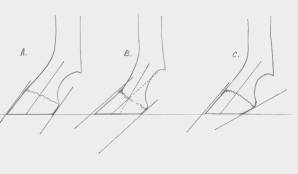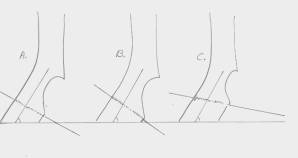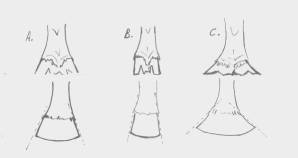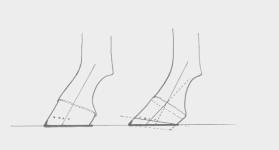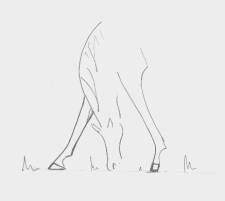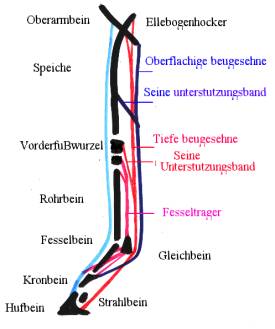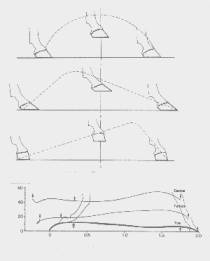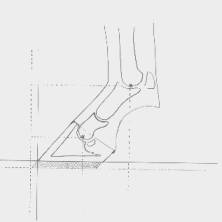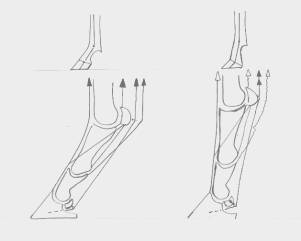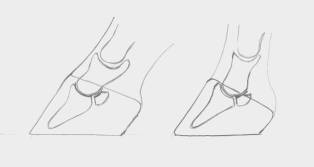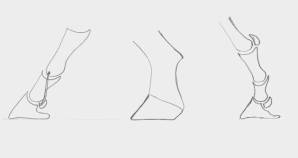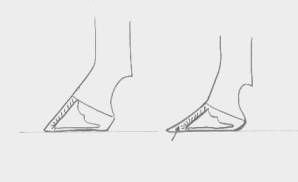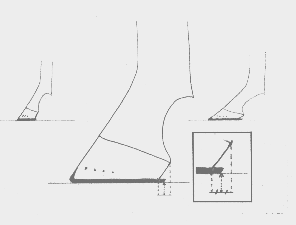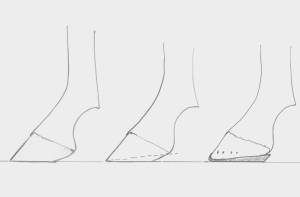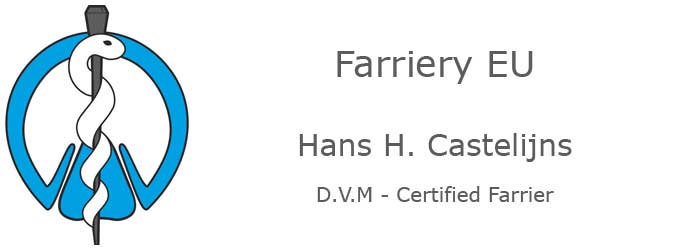 |
Trimming and shoeing in the sagittal plane (toe to heel) |
|||||||||||||||||||||||||||||||||||
|
|||||||||||||||||||||||||||||||||||
I. - DEFINITIONS:If the heels are too low, the position of the hoof axis will be incorrect and too flat. This condition can also be described as insufficient hoof wall in the area of the heels, or a surplus of hoof wall in the toe. In the latter case, the problem can be remedied by trimming the hoof. (Figure 1b) |
|||||||||||||||||||||||||||||||||||
|
|||||||||||||||||||||||||||||||||||
The condition of underrun heels applies when the toe and heel axes of the hoof are not parallel (Figure 1c). This means that the horn tubules, which run from the coronary band to the ground form a larger angle in the toe than in the heels.Although this hoof deformity is often treated as equivalent to low heels, it differs due to the fact that the hoof axis may not be broken and the hoof cannot therefore be corrected by trimming. |
|||||||||||||||||||||||||||||||||||
II. - CAUSES:a) Acute-angled hoof axis b) The position of the coronary band The position of the coronary band (Figure 2) is determined by the individual conformation of each horse. If the coronary band of the hoof is almost parallel to the ground and the hoof axis is unbroken, the heels are physiologically long. If the angle of the coronary band to the ground is very steep, however, the heels will be physiologically short. And if the coronary band curves towards the heels, the heels will be slightly underrun.Paradoxically, it is long heels, however, (with only slightly inclined coronary bands) that frequently form underrun heels, if they slope forwards. |
|||||||||||||||||||||||||||||||||||
|
|||||||||||||||||||||||||||||||||||
c) Flat hoofs (broad hoof with acute-angled side walls) Normal Narrow Flat hoof Hoofs are described as flat, if the angle of inclination of the hoof wall is very large in relation to the ground (Figue 3). This type of hoof has a very distinctive hoof mechanism and owing to the constant movement (expansion and contraction) may lead to exceptionally high wear of the heels, even in the case of shod horses. |
|||||||||||||||||||||||||||||||||||
|
|||||||||||||||||||||||||||||||||||
d) Degree of hoof moisture The hoof mechanism is not only determined by the shape of the hoof, but also by the moisture content. The internal parts of the hoof are relatively more moist and contract when the hoof loses moisture. A very moist hoof, on the other hand, expands. This means that, owing to their high elasticity and poor horn structure, the heels wear more quickly. e) Shoeing interval too long In general it can be said that the hoof mechanism and, as a result, the wearing of the heels, takes place even in the case of shod horses. This means that the horn wall grows in the toe region, but does not wear because of the shoe, while the horn wall of the heels also grows, but does wear. This imbalance is exacerbated the longer the period between shoeing. (Figure 4) |
|||||||||||||||||||||||||||||||||||
|
|||||||||||||||||||||||||||||||||||
f) Club foot The club foot (Figure 5) or grass foot is a special case. In this case, the particular behaviour of foals, who place one foot in front and the other under their body, in order to be able to graze better leads to the formation of two different hoofs. One hoof is a club foot with high heels and one has underrun heels. This behaviour is due to uneven development of the length of leg and neck (which I have often observed personally in Arab foals, who undergo growth spurts between four and eight months of age). |
|||||||||||||||||||||||||||||||||||
|
|||||||||||||||||||||||||||||||||||
g) Hoof correction and shoeing errors Frequently, the incidence of heels that are too low and/or underrun is due to hoof correction and shoeing errors. In some disciplines and riding traditions, these errors were virtually the norm and in a few cases remain so today. Examples are racehorses and trotting horses, Arab show horses, and of course, the hind legs of quarter horses in reining.In these disciplines the following justifications were and are used: "helps the speed" (trotting), "emphasizes the action" (Arab horses) and "the sliding stop can be better achieved in this way" (reining).I know racehorse breeders who require their farriers to make all hoofs flat and round, even if the heels have to be drastically cut back, without taking account of the hoof axis. The fear (which is also often justified) that the horse will overreach and in this way will pull off the front shoes, because it is "comfortably" shod the heels often leads to a horse being shod too short and/or too narrow. The result of this is, however, that if the shoeing interval is too long, the horse will have no heel protection.The fact that the hoofs of unshod horses with sufficient freedom of movement are relatively well formed is evidence that for many horses shoeing is often the reason for the heels being too low.A long toe touches the ground first and therefore wears more quickly. The weight is better distributed by the ciliary bodies, the bars and the hoof sole, which also partially come into contact with the ground and this can therefore lead to better heel growth. |
|||||||||||||||||||||||||||||||||||
III. - CONSEQUENCES:In order to be able to examine the consequences of defective limb posture, a thorough knowledge of the anatomy (Figure 6) and physiology of the horse is needed. Biomechanics and biokinetics, which explain the forces and levers and the movement of the equine "machine" are particularly important. |
|||||||||||||||||||||||||||||||||||
|
|||||||||||||||||||||||||||||||||||
a) Biokinetics Let's start with a few preliminary comments regarding biokinetics (Figure 7), which have already shown that the old model is incorrect with regard to the effect of the hoof axis on the movement curve of the limbs, even if this model has been passed on for decades in various books on shoeing and hoof care (see Ratzlaff, Clayton, Balch and Vanschepdeal).The swing phase of the limbs describes a fairly flat curve with two high points. The curve described remains relatively unchanged, irrespective of the hoof angle.If a horse's heels are too low and therefore the toes are too long, the hoof has different impact and support phases: toe impact and delayed breakover. As a result, the support phase is shifted under the horse's body. |
|||||||||||||||||||||||||||||||||||
|
|||||||||||||||||||||||||||||||||||
b) Biomechanics 1) Length of the lever Increasing length of the lever from the toe bearing surface to the coffin joint and to the centre of the fetlock joint. () |
|||||||||||||||||||||||||||||||||||
|
|||||||||||||||||||||||||||||||||||
2) Uneven pressure on the suspensory structure of the fetlock joint Uneven pressure on the suspensory structure of the fetlock joint. (Figure 9) The hoof capsule and with it the third phalanx are more inclined and in this way exert pressure on the tendon of the deep digital flexor muscle. This results in a verticalization of the first phalanx and leads to a reduction in the pressure on the tendon of the superficial digital flexor muscle and the suspensory ligament of the proximal sesamoid bones. Importantly, the acute angle exerts greater pressure on the podotrochlear bursa since the tendon of the deep digital flexor muscle runs around the navicular bone. |
|||||||||||||||||||||||||||||||||||
|
|||||||||||||||||||||||||||||||||||
3) Change in the interrelationship in the coffin joint The second phalanx straightens in relation to the third phalanx, (Figure10) and comes into greater contact with the navicular bone, which in turn cannot move downwards because its collateral ligaments connect it to the distal ends of the first phalanx. This overloading takes place primarily during the push-off phase. (Figure 11) |
|||||||||||||||||||||||||||||||||||
|
|||||||||||||||||||||||||||||||||||
4) Contusions and minor injuries Short heels, together with soft bars and a highly developed frog, expose all of the rear hoof area to a number of contusions and injuries. This may lead to minor bruises on the angles of the sole, but also result in a negative effect on the podotrochlear bursa. 5) Overloading of the lamella of the corium If the toes are too long, they give rise to increased pressure on the lamella of the corium in the toe area (Figure 12), particularly if the dorsal hoof wall, which is no longer parallel to the third phalanx, becomes concave in shape.The considerable pressure exerted by the tendon of the deep digital flexor muscle leads to an expansion of the white line in the toe area. This results in seedy toe and, in rare cases, also laminitis. |
|||||||||||||||||||||||||||||||||||
|
|||||||||||||||||||||||||||||||||||
6) Excess pressure on the coronary pad If the heels are too low, this leads to excess pressure on the coronary pad at the rear of the foot, which results in weaker growth of this area and often results in a vicious circle. |
|||||||||||||||||||||||||||||||||||
IV. SOLUTIONSTechniques for correcting the defects of heels that are too low and/or underrun range from the fundamental rules of hoof care to the most complex of methods as follows: 1) Correct shoeing period The shoeing period must be tailored to each individual horse. In particular, horses with flat hoofs should be shod more frequently. 2) Correctly fitting ("comfortable"), wide and long shoe branches. The branches of the shoes should be made correctly fitting, wide and long.An appropriate rule in this regard could be as follows: The branches of the shoe should protrude at the back so far that they are halfway between the heels and a vertical projection of the bulbs. (Figure 13) |
|||||||||||||||||||||||||||||||||||
|
|||||||||||||||||||||||||||||||||||
3) Rasping of a concave digital wall When rasping a concave digital wall, care should be taken to ensure that it is parallel to the third phalanx. If the toe is allowed to project slightly over the edge of the shoe, the centre of gravity of the shoe will coincide better with a line projected from the midpoint of the coffin joint. Shoes without toe clips or with side toe clips will be used for the front hoofs. A similar result will be achieved by forging the toe direction in or on the shoe. 4) Direct the bearing surface of the shoe inwards In order to reduce the excessive hoof mechanism of the flat hoof, the bearing surface of the shoe can be turned inwards. Side toe clips that are positioned on the furthest points of the shoe also serve the same purpose, however. 5) Egg bar shoes A further improvement in the bearing surface in the toe region can be achieved by using an egg bar shoe. The result is that the heels will sink less into the ground and there will be better coincidence of the midpoint of the shoe and the centre of the coffin joint. 6) Reverse shoe An improvement on the egg bar shoe is the use of the reverse shoe with or without side toe clips. Apart from the benefit of a larger bearing surface in the heel region, better breakover of the hoof is achieved. Through this solution, the toes wear slightly between shoeings. 7) Wedge shoes The hoof axis can be reinstated by using wedge shoes or shoes plus pads. Sometimes, wedge shoes are used if there are problems with underrun heels. In this case, it is necessary, however, to make sure the heels are properly balanced for the moment, in order to remove the area in which the horn tubules slope forwards (Figure 14). Even if this is correct in theory, it is always difficult to shorten atrophic heels further. It is, however, possible to use an egg bar shoe in combination with elevated heels and padding or an egg bar shoe with elevated heels made from a metal alloy (for weight reasons). A disadvantage of using these light metal alloys is that heels with a pronounced hoof mechanism tend to give rise to grooves caused by abrasions on the bearing surface of the branch of the shoe. |
|||||||||||||||||||||||||||||||||||
|
|||||||||||||||||||||||||||||||||||
8) a. Unshod horse The simplest method, which was often used in the UK for hunters in summer, was to give the unshod horse sufficient turnout and to regularly trim the hoofs and shorten them in the toe region. b. Heart bar shoe Using the heart bar shoe, the frog, which is often overdeveloped in flat hoofs can be exercised, because the branches are in contact with the frog.A disadvantage of this shoe is that it is not suitable for competition horses, however, as the pressure that the branch exerts on the podotrochlear bursa through the frog, the frog pad and the tendon of the deep digital flexor muscle may be too great. It is even less suitable for horses who already have navicular disease. c. Padding and pads and the use of synthetic materials (silicones) The use of padding makes it possible to pad out the space between the pad and the bars, the frog and the sole so that all parts of the area of the sole are continually used to carry the bodyweight and therefore reduce the burden on the hoof wall. Normally, the synthetic material (between the pad and the sole) is applied while the hoof is raised off the ground and should also dry or harden in this position, thereby preventing some of the synthetic material, which is still liquid, from leaking out and therefore reducing the effect or even leading to small changes in the hoof capsule, including the sole, when the hoof makes contact with the ground. A variant of this shoe can be achieved by making perforations in the pad through which the synthetic material can flow through and then be made smooth so that it forms one surface with the shoe.This shoe has the following disadvantages, however. It is very expensive, it may give rise to thrush and finally the hoof wall must have a discreet strength, because this shoe must be secured or held with nails. 9) Artificial reconstruction of the heels Finally, it is possible to reconstruct the heels using qualitative synthetic resins. These are resins that not only adhere very well, but also have to be very pliable in relation to the movement of the heels.The prerequisites for applying this method are an extremely clean working area and a very patient and quiet horse, because the heels have to be built up in layers in order to avoid sensitive regions of the hoof from overheating while the resin is drying. A further important fact is that the horse owner must be able to afford the considerable time and costs involved. |
|||||||||||||||||||||||||||||||||||
V. - CONCLUSIONSFinally, I would like to emphasise, however, that there is no general shoeing solution to hoof defects, but a series of methods and techniques that must be selected and adapted according to the requirements of each individual horse, or even of each individual foot problem. |
|||||||||||||||||||||||||||||||||||
Hans Castelijns
D.V.M - Certified Farrier

